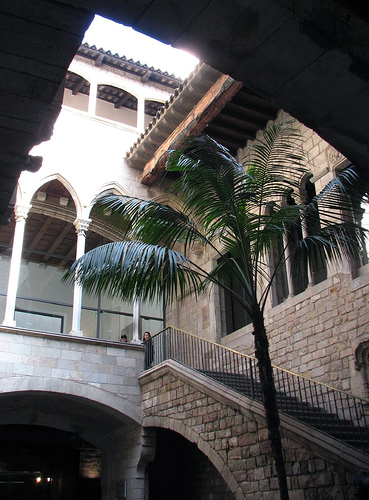TLV to Barcelona (BCN)
Spain
Barcelona
CityBCN
IATA3087.4 km
Distance4h 14m
Flight TimeCoordinates: 41.2971, 2.07846
Airlines:
About Barcelona

City in Catalonia, Spain
Barcelona is a city on the northeastern coast of Spain. It is the capital and largest city of the autonomous community of Catalonia, as well as the second-most populous municipality of Spain. With a population of 1.7 million within city limits, its urban area extends to numerous neighbouring municipalities within the province of Barcelona and is home to around 5.7 million people, making it the fifth most populous urban area of the European Union after Paris, the Ruhr area, Madrid and Milan. It is one of the largest metropolises on the Mediterranean Sea, located on the coast between the mouths of the rivers Llobregat and Besòs, bounded to the west by the Serra de Collserola mountain range.
🌐 Read more on WikipediaWeather in Barcelona
Museum of the History of Catalonia
The Museum of the History of Catalonia (Catalan: Museu d'Història de Catalunya, MHC) is a history museum in Barcelona that promotes the awareness and knowledge of the history of Ca…
Palau Reial Major
The Palau Reial Major (Catalan pronunciation: [pəˈlaw rəˈjal məˈʒo]; "Grand Royal Palace") is a complex of historic buildings located in Plaça del Rei, Barcelona, Catalonia, Spain.…
Barcelona Cathedral
The Cathedral of the Holy Cross and Saint Eulalia (Catalan: Catedral de la Santa Creu i Santa Eulàlia), also known as Barcelona Cathedral, is the seat of the Archbishop of Barcelon…
Plaça del Rei
Plaça del Rei (meaning "King's Square" in Catalan, in Spanish: Plaza del Rey) is a 14th-century medieval public square in the Barri Gòtic of Barcelona, Catalonia, Spain. The square…
Palau del Marquès de Lió
The Palau del Marquès de Lió is a civic building located at number 12 of Montcada street at the Barri de la Ribera district of Barcelona. Throughout its history has been the reside…
Museu Frederic Marès
The Museu Frederic Marès [muˈzɛw fɾəðəˈɾiɡ məˈɾɛs] is an art and sculpture museum in the Palau Reial Major in Barcelona, Spain. The Museu contains thousands of items from the colle…
Basilica of Saints Justus and Pastor
The Basilica of Saints Justus and Pastor (Catalan: Església dels Sants Just i Pastor) is a basilica in Barcelona, Catalonia. In 1948 this church became the sixth in Barcelona to re…
Palace of the Generalitat of Catalonia
The Palace of the Generalitat of Catalonia (Catalan: Palau de la Generalitat de Catalunya, IPA: [pəˈlaw ðə lə ʒənəɾəliˈtad də kətəˈluɲə]; Spanish: Palacio de la Generalidad de Cata…
Topos V
Topos V, or simply Topos, is a sculpture by the Basque artist Eduardo Chillida, from 1986, standing at Plaça del Rei in the Gothic Quarter of Barcelona. Purchased by Barcelona muni…
Museu Picasso
The Museu Picasso (Catalan pronunciation: [muˈzɛw piˈkasu], "Picasso Museum") is an art museum in Barcelona, in Catalonia, Spain. It houses an extensive collection of artworks by t…
Santa Maria del Mar, Barcelona
Santa Maria del Mar (Catalan pronunciation: [ˈsantə məˈɾi.ə ðəl ˈmaɾ], "Saint Mary of the Sea") is a church in the Ribera district of Barcelona, Catalonia, Spain, built between 132…
Museu de la Xocolata
Museu de la Xocolata or Museo del Chocolate in Spanish, ("Museum of Chocolate") is a private museum in Barcelona, Catalonia, Spain, owned by the Gremio de Pastelería de Barcelona …
Plaça Sant Jaume
The Plaça de Sant Jaume (Catalan pronunciation: [ˈplasə ˈsaɲ ˈʒawmə], in English "Saint James's Square") is a square at the center of the Old City of Barcelona and the administrati…
Archdiocese of Barcelona
The Archdiocese of Barcelona (Latin: Archidioecesis Barcinonensis) is a Latin metropolitan archbishopric of the Catholic Church in northeastern Spain's Catalonia region. The cathe…
Brossa Espai Escènic
Brossa Espai Escènic (Brossa Scenic Space in Catalan) is a small theatre in Barcelona inaugurated in December 1997. It is intimately related to the creative universe of Joan Brossa…
Roman walls of Barcelona
The Roman walls of Barcelona (Catalan and Spanish: Muralla romana de Barcelona) are an archaeological and monumental complex comprising the remains of the wall built to protect Bar…
Fossar de les Moreres
The Fossar de les Moreres (Catalan pronunciation: [fuˈsa ðə ləz muˈɾeɾəs], literally "Grave of the Mulberries") is a memorial square in Barcelona (Catalonia, Spain), adjacent to th…
Museum of the History of Barcelona
The Museum of the History of Barcelona (Catalan: Museu d'Història de Barcelona, MUHBA) is a history museum that conserves, researches, communicates and exhibits the historical heri…
















